Sunshine buys Esmeralda Group
While those of us in the bedding plant and nursery world have been locked down or selling out this spring or attending virtual trade events, the cut flower world has seen some big news in the form of an acquisition. On June 26, two cut flower giants, Sunshine Bouquet Company and the Esmeralda Group, entered into an agreement in which Sunshine Bouquet will acquire all the operations of the Esmeralda Group in Ecuador, Colombia and the United States. The only asset not included is Esmeralda’s flower breeding operations.
With a combined 1,200 hectares (2,800 acres) of farms in Colombia and Ecuador, Sunshine is now the largest cut flower producer in South America, and one of the top five in Colombia—and perhaps the largest in the world. They'll also be the largest—or one of the largest—bouquet makers in the world.
Marta Pizano, FloraCulture International’s Colombian correspondent, interviewed John Simko, president and CEO of Sunshine Bouquet, to learn more about what she calls “a shining example of vertical integration … bring(ing) together production, supermarket sales and wholesalers under one roof, creating a giant that is set to be a true game-changer in the global floriculture scene.”
Here’s what she learned:
John is at least a third generation cut flower man; his grandfather started a cut flower nursery in New Jersey in 1936; under John’s parents it grew into a major cut mum supplier. But competition from states with milder climates and from offshore production made them decide to get out of production to focus on the retail and wholesale flower business to supply imported cuts. Eventually, John bought the business from his parents, continuing the retail/wholesale business. He recognized opportunities in the mass market floral business, so in 1985, he established the Sunshine Bouquet division in Colombia; in 2001, they purchased their first Colombian farm and through additional purchases have grown steadily since then.
Why purchase Esmeralda? The sudden death in 2016 of Esmeralda founder Peter Ullrich, a long-time friend of John’s, was the catalyst.
“I always admired his entrepreneurship, the quality of the flowers coming out of his farms, his grasp of the business and his vision,” John told Marta. In 2019, John met Peter’s widow, Clarisse, at the Proflora show in Bogota.
“Peter’s sudden death in 2016 had a huge impact on the Esmeralda Group,” John says. “Clarisse and I got talking and a project started to take shape.”
Through the acquisition, Sunshine and Esmeralda bring together about 2,800 acres of cut flower production in Colombia and Ecuador. The Ecuadorian farms now make Sunshine the largest flower grower/exporter in Ecuador. Staff-wise, Sunshine Bouquet was already providing almost 15,000 jobs; with Esmeralda they will add 2,000 to 3,000 more.

(From the Sunshine Bouquet website.)
How will the new company operate? “Sunshine and Esmeralda will keep their identities,” says John, adding that he took this step to build, enhance and develop, not to disrupt great achievements that have already been reached. The only branch that will disappear is Connectaflor, Esmeralda’s Miami-based distributor for North America, which will stop operating this month (August 2020). Esmeralda staff will continue to cater to wholesalers and international markets, without any substantial changes.
“It’s a fantastic, highly efficient team and the name is held in very high regard,” John says.

How did Sunshine fare this spring?
COVID was extremely hard on the cut flower business due to the almost complete shutdown of florists and flower events. Supermarkets stayed open, however, and with them their floral departments.
When cargo capacity out of South America became limited due to lack of flights and exporters were scrambling to ship flowers, Sunshine was able to charter their own planes, delivering flowers to their customers on time. At most, they had to discard 20 million flower stems; John says he feels they fared well, as that really is not very much for such a large company. They also didn’t have to cancel any contracts or dismiss any staff. They took a hit from the pandemic, but have bounced back, and demand for flowers is strong, John says.
“I guess people like to see pretty beautiful flowers when they have to stay home.”
In ending his conversation with Marta, John expresses his overall satisfaction with his career in the flower business. Wrote Marta, “He is a true believer in the benefits flowers can bring to people, both customers and workers: ‘To think that we are helping so many people make a living, particularly at a time of crisis, gives me enormous satisfaction.’”
John Simko will be speaking at the “Recovery from Crisis—The future for Ornamentals” conference on September 15. He will share his perspective on how the retail market for flowers has been impacted by the pandemic, how it will develop in the future and how the supply chain needs to respond. To find out more, visit www.aiph.org/conference-2020.

“Poinsettias: A Midseason Grower Check-In” webinar
It’s not too late to sign up for the above-titled webinar, which will feature Syngenta Technical experts Karl Trellinger of Syngenta Flowers and Nancy Rechcigl of Syngenta Crop Protection.
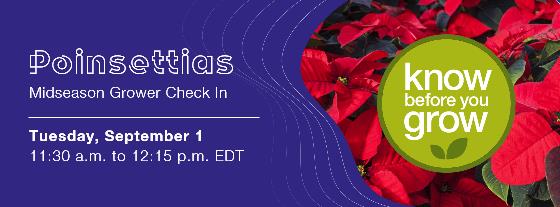
This 45-minute webinar takes place on Tuesday, September 1 at 11:30 a.m. Eastern/10:30 a.m. Central, and is focused on professional tips for greenhouse growers finishing poinsettias, including common cultural blunders like fertility, pest and disease controls, and much more.
Register for the free webinar HERE.
This webinar is one of many in the new series of “Know Before You Grow” technical webinars hosted by Syngenta Flowers and Syngenta Crop Protection on pertinent, timely cultural topics.
AAS adds new trials
(Thanks to Jen Polanz for the following report based on a Zoom meeting with AAS.)
All-America Selections (AAS) has been around for nearly 90 years, but the organization hasn’t become complacent. Instead, it’s adopted new technology and adapted to create new trials to accommodate modern breeding.
First, to understand what’s new, you have to know the trials AAS currently holds. The existing trials are:
- Edibles from seed, in ground
- Ornamentals from seed, in ground (annuals and first-year flowering perennials)
- Ornamentals from vegetative cuttings, in containers (annuals and first-year flowering perennials)*
- Herbaceous perennials, in ground (three-year trial)
Those trials will continue to exist (with one renamed—see the asterisk) along with two new trials, which will be located at 24 sites to be announced at the end of September:
- Edibles from seed, in containers
- Ornamentals from seed, in containers
- Ornamentals from non-seed propagation methods, in ground (annuals and first-year flowering perennials)*
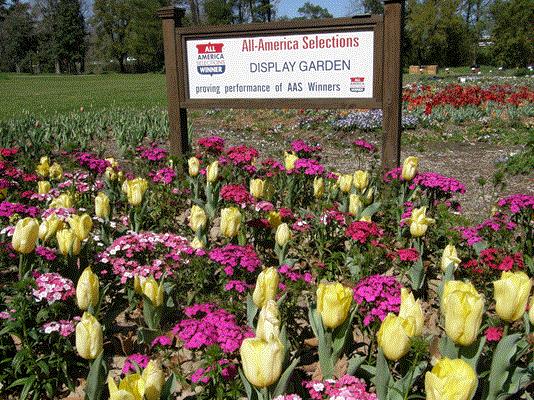
Along with the new trials, there are a couple of rule changes for breeders: Any variety entered into the AAS trials will be allowed to be sold in the North American home garden market after entry. That means breeders can sell their variety while it’s in trial. Breeders also can sell it as an exclusive while it's in trial, but if it wins an AAS award, it’s not allowed to be an exclusive anymore.
Lastly in AAS news, the organization adopted new technology last year in the form of the Mercado Trial App, which gives judges an easier way to record observations and input scores, which can then be quickly transmitted to the office for data collection. There also will be a new judge application and other additions to the breeder entry applications.

What's new in automated cart pullers?
Along with Ball Publishing’s Allison Westbrook and Bill Calkins, I’m deep, deep, deep in the trenches of editing the upcoming 19th Edition of the Ball RedBook (to be published sometime this winter). I’m responsible for Volume 1, "Greenhouses, Equipment and Technology," so those three topics have been on my mind of late and I thought I’d share some new technology I just learned about.
The first comes from Emsflower, a giant bedding plant greenhouse combined with an open-to-the-public greenhouse tourist attraction in Emsbüren, Germany. In the 18th RedBook, I wrote about their unique internal transport system made up of big flatbed self-tracking wagons that have computer-controlled hitches that grab onto an in-floor chain system. The computer told the hitch which “stations” to stop at within the greenhouse and production area. The carts are unloaded by overhead gantry-style cranes.
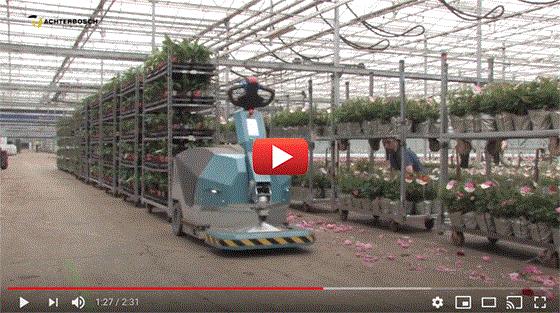
Knowing the technology might have changed since 2007, I emailed inventor Tom Kuipers (son of owner Bennie Kuipers) for an update. Tom replied that they’ve replaced the chain with induction wires embedded in the floor and replaced his computerized hitches with a device called a Rhino from Achterbosch Machine Company. The basic idea is the same, however, the master computer tells the wagons where to go, and when, so plants are automatically carried in and out of the greenhouse.
You can see if all in action in this cool VIDEO Tom linked me to.
Something new I noted at Emsflower: The same Rhino automated vehicle technology is used to pull trains of shipping racks through the facility, again following buried induction wires. These Rhinos (which are the original versions; the ones pulling the wagons seem to be modified versions of these) have a handle like you’d find on a pallet jack that allow human operators to take over control of the Rhino for manual guidance onto a truck or what-have-you.
Why invest in this sort of automation, you ask? With 154 acres of bedding and garden plants and vegetable production at one site, do you really have to ask?

Look, ma, no wires!
Also this week, Rob Lando of AgriNomix shared THIS VIDEO of a similar tool being tested by Advanced Intelligent Systems (AIS) of British Columbia, Canada. AIS’s “CartPuller” will do the same task as the Rhino except without the need for any embedded wires or other external guidance tools. It’s fully autonomous, meaning it’s guided by … well, they don’t say other than "artificial intelligence-based controllers" (and a bit of voodoo, I’m sure).
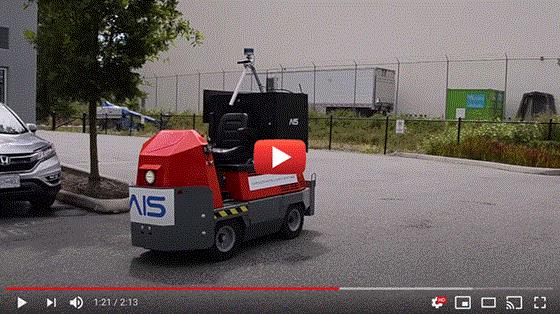
As with the ones at Emsflower, they’ll be handy for transporting empty carts into the greenhouse for loading, then hauling filled carts to the shipping area for loading onto trucks. The benefit over the Rhino is no wires needed, so presumably it will be able to go anywhere … maybe down the road to the store, eliminating your fleet of trucks!
lēf video worth a watch
lēf Farms, the greens-producing sister company to Pleasant View Gardens in Loudon, New Hampshire, sent me a press release saying their various greens blends (such as “Smooth,” “Spicy,” “Fusion” and “Crisp”) are now being stocked by more than 200 Stop and Shop stores in Massachusetts, Connecticut and Rhode Island. The release also mentioned that lēf has also donated more than a quarter million dollars worth of fresh greens to front line hospital workers in New England and New York. Well done on both accounts.
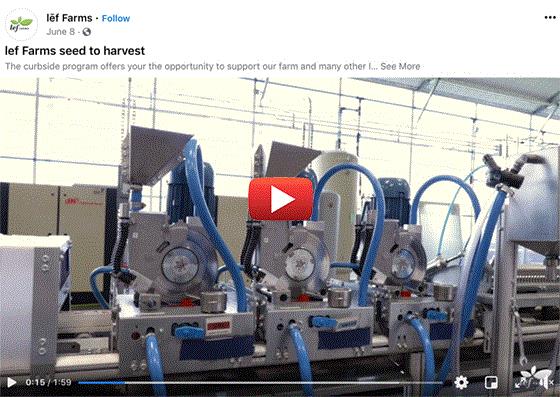
But also interesting in the release was a link to THIS VIDEO called Seed to Harvest, which lets you see the inner workings of lēf’s fascinating hydroponic trough production system, unique vertical drum seeders (they look like meat slicer blades), touch-free harvest system (they may BE meat slicer blades) and more. Impressive!
PPA news
That’s the Perennial Plant Association, for those who didn’t know, and they’ve dropped two bits of news in my inbox:
First up, the organization's sleek new logo:
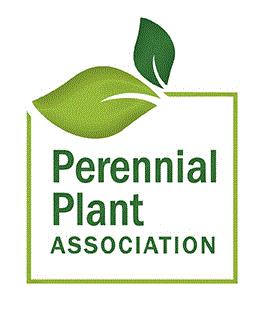
Second, the 2021 Perennial Plant of the Year has just been announced and it’s an easy one for anybody to grow: Nepeta (Calamintha nepeta ssp. nepeta).
Commonly called lesser calamint, its tiny white flowers (sometimes touched with pale blue) appear from early summer to fall on this plant. Undemanding and dependable, it provides the perfect foil for other summer bloomers and foliage. It’s a full-sun perennial with a low mounding or bushy habit that’s ideal for the front of the border, rock gardens and more. And while both durable and pest-free, calamintha also checks two important boxes for gardeners: bees and other pollinators work the flowers throughout the summer, and the aromatic foliage is deer-resistant.
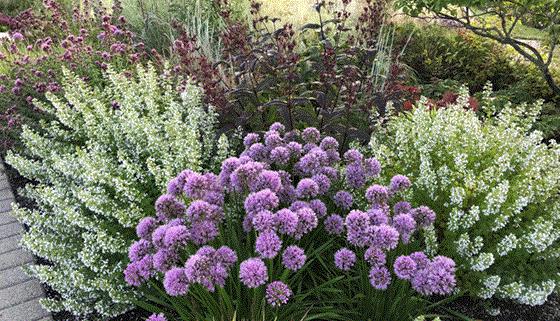
Nepeta looking sporty with allium. Photo: Midwest Groundcovers.
The Perennial Plant of the Year program began in 1990 to showcase a perennial that's a standout among its competitors. Perennials chosen for this honor are suitable for a wide range of growing climates, require low maintenance, have multiple-season interest and are relatively pest/disease-free.
PPA members have access to a flyer, poster and bench card to assist with promoting the Perennial Plant of the Year.

Learn to breed hemp and make seed
Here’s some high-level online education for those of you who want to know more about breeding and producing hemp seed. Developed by the University of California-Davis Seed Biotechnology Center, it’s a three, half-day online course slated for October 27-29.
Designed to enhance the knowledge of professionals working on hemp improvement and propagation, the course covers hemp seed production topics such as flowering, pollination, seed development, harvesting and certification. Course participants will also learn about hemp genomics, genetics, sex expression, types of cultivars with corresponding breeding schemes and intellectual property protection options. Instructors include experts from the public and private sectors
It doesn’t sound like this is for the casually curious, does it? And the price tag reinforces that: $1,050 before September 15, $1,150 after. Still, this sounds like tremendous information for those who desire it.
For more, click HERE or email Kelsey Maher at kjmaher@ucdavis.edu.

New Hollywood Hibiscus
Feeling out of touch, new variety-wise, because of lack of travel? Fear not: here are a few that have come across my desk recently that I think are worth sharing:
From J. Berry comes three new Hollywood Hibiscus. Earth Angel has long-lasting pure white flowers against deep green foliage. The plants are well-branched, but naturally compact, and are said to be resistant to bacterial leaf spot and whiteflies.
Glamour Gal (below) offers the same attributes, but with deep pink flowers.
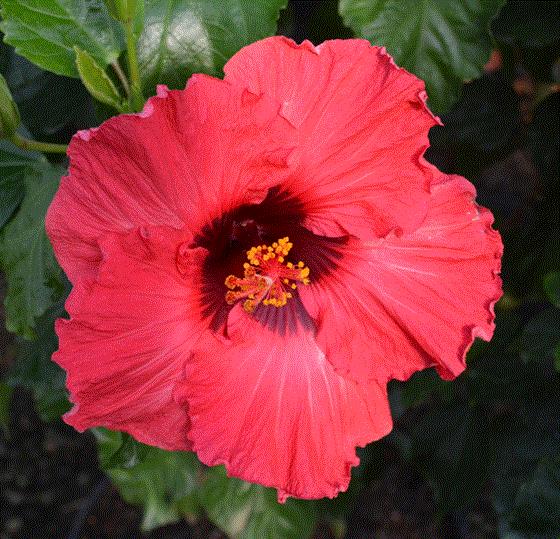
Pop Star (below) does as well, but with “peppy” pink flowers. Love ‘em all!
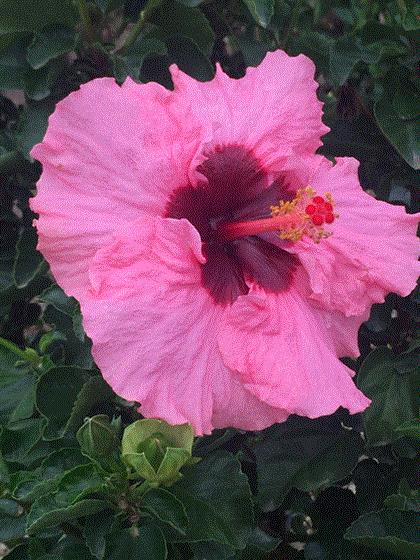
Also from Jim and his crew comes another Black Diamond crape myrtle, Radiant Red.
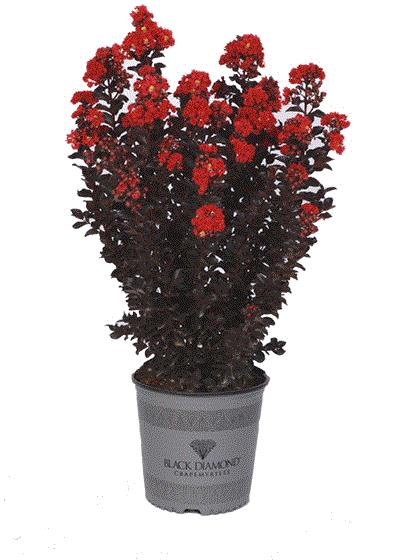
The Black Diamonds have very dark foliage, a natural vase-shaped habit and resistance to leaf spot. The flowers come on in summer and last until frost. Radiant Red brings the color selection to 10.
Four new ones from Bloomin’ Easy
These four varieties from Bloomin' Easy launched at Cultivate’20—well, at the virtual version of the show—which means you may not yet know about them.
Beekeeper Caryopteris. This Caryopteris x clandonensis is an improvement in color and form of blue beard (or blue mist, if you prefer). Growing 2- to 3-ft. tall in full or part sun, it’s hardy in Zones 5 to 9.
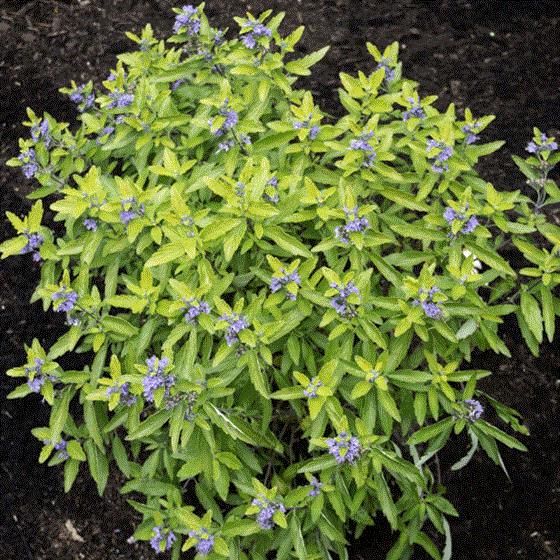
Beekeeper. Great name!
Cherry On Top Sorbaria is a dwarf sorbaria with cherry-red seed pods that extend the season of attraction. Grows 4- to 5-ft. tall and wide in full or part sun. Zones 2 to 10, meaning anybody can grow it!
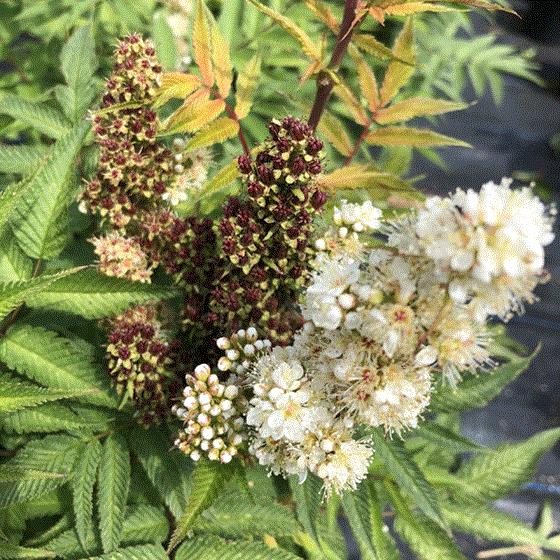
Cherry on Top.
Kimono and Starfield Hydrangea are reblooming Hydrangea macrophyllas. Kimono features bright red flowers with a white background and dark foliage that gets darker as the season goes on; while Starfield has pink star-shaped flowers. Both are strong rebloomers, but they say Starfield is “one of the heaviest-flowering hydrangeas you’ll ever encounter.” Both grow 2- to 3-ft. tall and wide and are hardy in Zones 5 to 9.
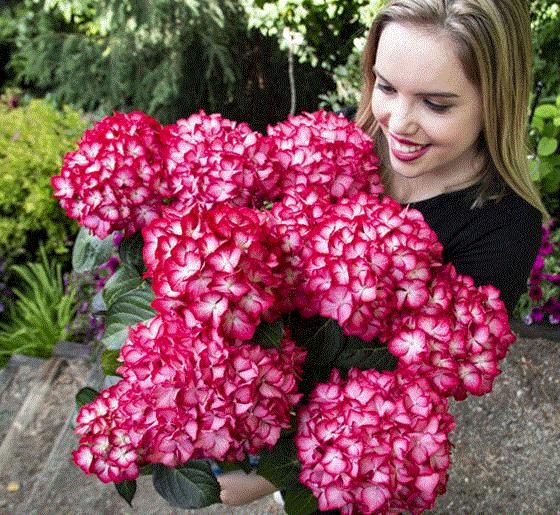
Kimono.
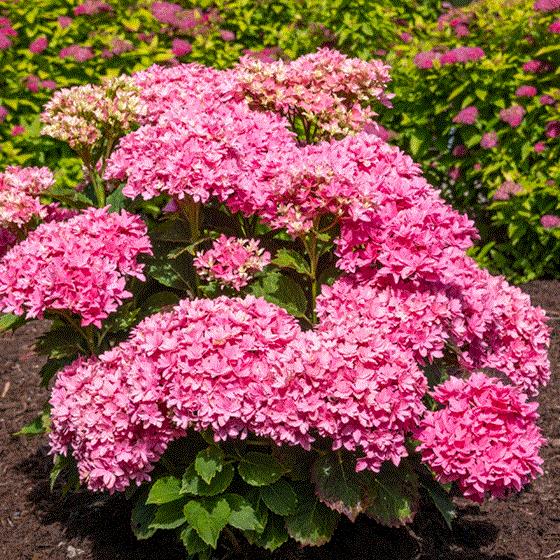
Starfield.
Bloomin’ Easy’s slogan is “Plant, Water, Relax” and they say these four introductions fit the young homeowners’ modern-sized outdoor space and busy lifestyle.

Inspiring planter ideas from Kinsman
It’s been a while since I’ve seen inspiring combo planter designs worth sharing with you, but I’ve just discovered four courtesy of Kinsman Company, a seller of specialty garden products. Kinsman held a contest for retail customers to use their line of Pamela Crawford Side Planting Containers (wire basket with coco liners designed to be planted through the side as well as the top). They selected four winners of the contest, which ended August 3. Here are the designs, which I find to be attractive and inspiring. I do note that they don’t all include a list of varieties, but you guys and gals are smart and can figure it out!
1st Place—Basket Column Kit for Large Pots
Dawn White, Loudon, Tennessee
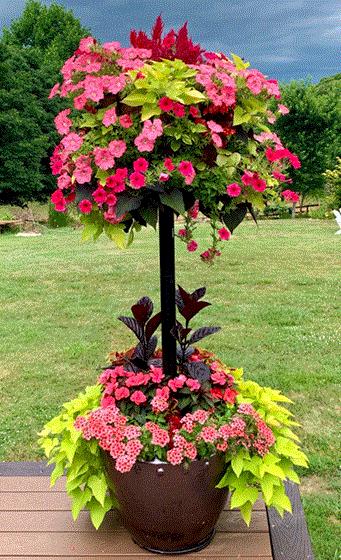
“I had wanted to buy this planter system for years and the 2020 quarantine seemed like the perfect time for a fun garden project! I wanted to create a cheery pop of color on my back deck to brighten my family and my neighbors’ days, so I used bright pinks, corals, and lime green plants and foliage to achieve the look.”
2nd Place—Imperial Hanging Planters
Cindy Penick, Boone, North Carolina
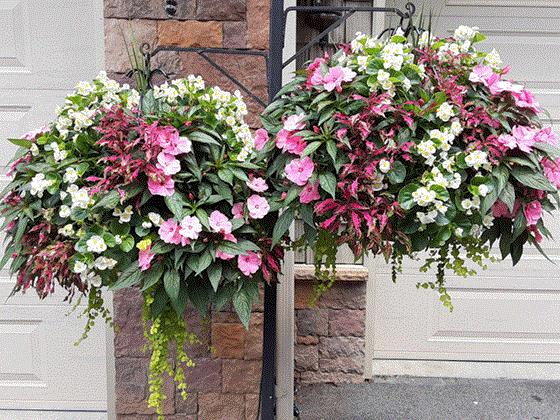
“These are planted at my garage. They consist of creeping Jenny, pink cream New Guineas, white begonias, Chaotic Rose Coleus and green dracaena in the center."
3rd Place—Living Wall Planters
Diana Keller-Fernandez, Beverly, Massachusetts
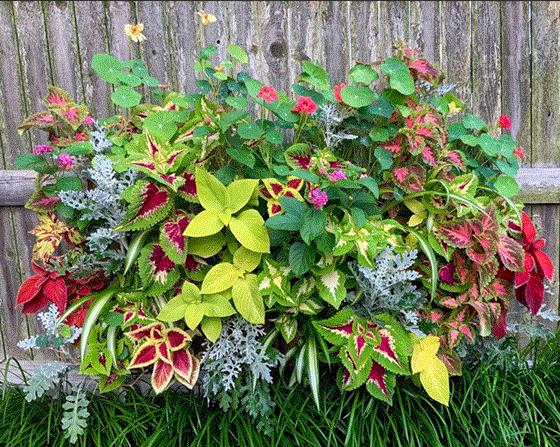
“I needed to be a bit more resourceful in procuring plant material this year due to COVID. I filled my two side-by-side planters with my indoor spider plants and some overwintered coleus cuttings. To attract hummingbirds and butterflies I added Lantana Athens Rose, dusty miller and nasturtium seeds (Hummingbird Vanilla Berry and Mounding Cherries Jubilee). The yellow rudbeckia adds a happy, sunny ‘floor’ from which the columns rise.”
3rd Place—Wooden Border Columns with 14-in. Basic Basket Planters
Lorrie Krynock, Appleton, Wisconsin
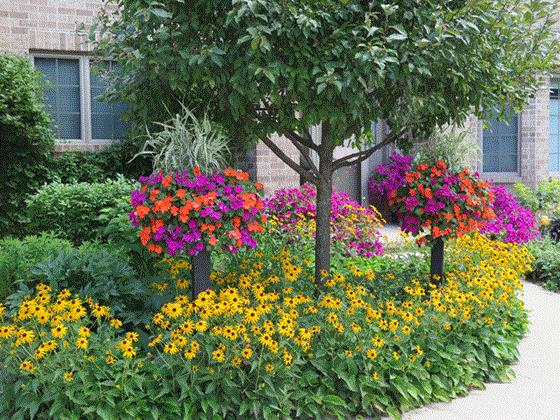
“I love color and the energy created between ‘hot’ colors. Every year, I plant Wave Petunias in purple that cascade down my front porch. To complement those plantings, I created two matching Kinsman columns using impatiens (in fuchsia and orange). I searched my area to find just the right centerpiece plants, something that would add coolness to complement the hot colors, but was not happy with anything available. I decided to use ribbon grass that I thinned from my perennial beds."
Finally …
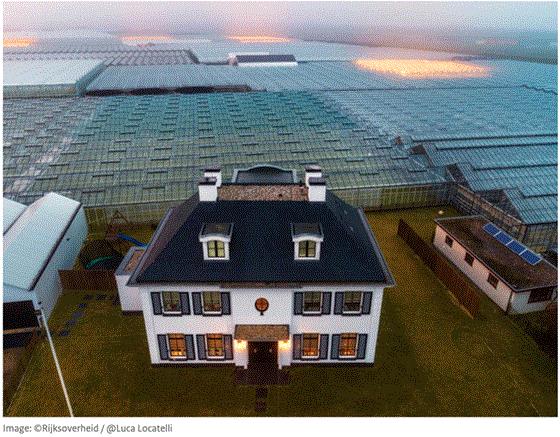
Have you always wanted a backyard greenhouse? If this property ever comes up for sale, you’ll be set! (Shot in the Westlands of the Netherlands by award-winning photographer/film-maker Luca Locatelli for his “Hunger Solutions” story in National Geographic.)
Remember: Be positive, but test negative!

Chris Beytes
Editor
GrowerTalks and Green Profit
This e-mail received by 21,940 loyal readers!
Thanks to my loyal sponsors, who help me reach the 21,940 readers of Acres Online in 66 countries. Want to be one of them (a sponsor, that is)? Give Paul Black a shout and he'll hook you up.